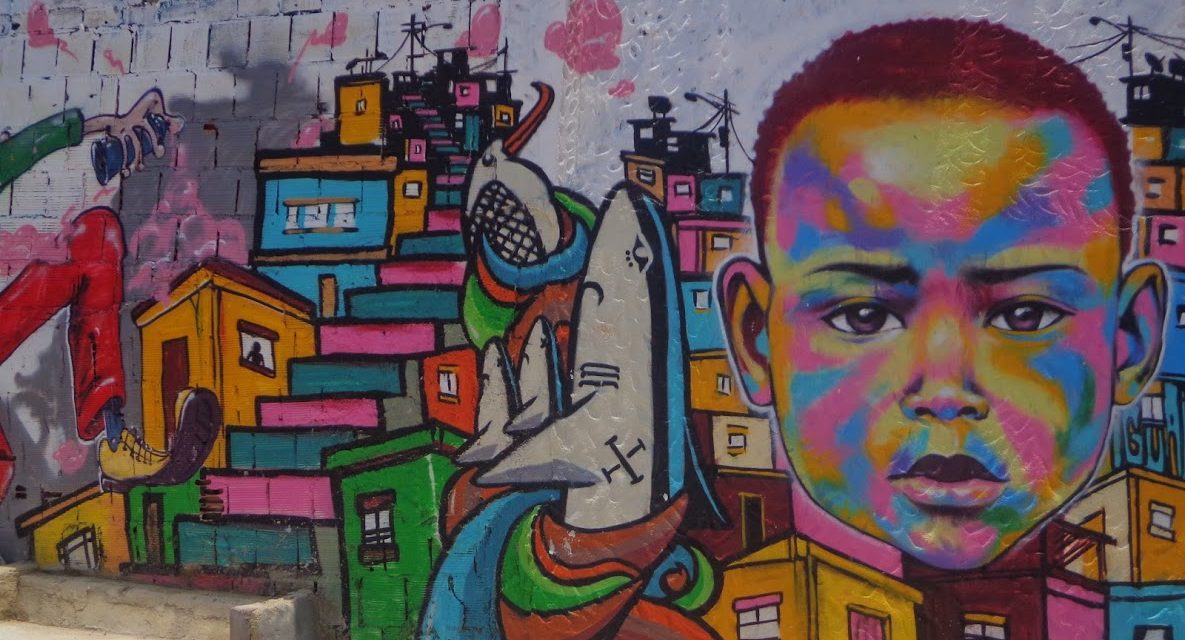By Katlin Cilliers | Staff Writer
“Are you from Rio?” is one of the first questions I hear when I tell people I am from Brazil. Home to one of the world’s modern wonders – the statue of Christ the Redeemer – Rio is usually the first thing that comes to mind when we think of the country. Although Rio is indeed a wonderful city with breathtaking views, there is much more to Brazil than its postcard city. Here are some must-have experiences for those who wish to pay a visit to Samba land.
Eat at a churrascaria
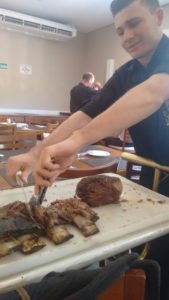
Beef ribs have are served in their own special cart. Just keep bringing it. (Photo by Katlin Cilliers)
Think meat. Loads of it, served non-stop. Beef cuts such as picanha, cupim, and maminha are only found in Brazil, which makes the experience of eating at a churrascaria a unique one to visitors. Most steakhouses have a green and red sign on the table, where green means “keep serving me,” so waiters keep coming by your table with the barbecued meat on a skewer, providing you with slices and chunks of meat to taste, unless you flip the sign to red. If you find the space, you can try salads and other local dishes from a self-serve buffet bar. To help wash it down, you can pick from light beers to freshly squeezed fruit juice, such as orange, passionfruit or acerola, a cherry-like, tangy fruit, rich in vitamin C.
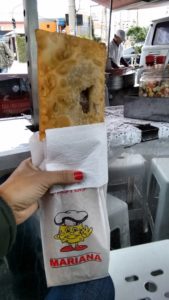
Pastel Especial – The special version of deep-fried pastry, stuffed with mince meat, ham, cheese, hard-boiled eggs and spices. The regular version is usually half the size of the photo’s. (Photo by Katlin Cilliers)
Eat pastel at a street market
Brazilian farmers markets are quite like the ones we see here, with a few unique characteristics. Because there is a large variety of fruits and vegetables, street markets take on entire streets with hundreds of stands. Competition runs wild when stand owners want to sell their produce over their neighbors’. Going to a Brazilian feira – street market – is an explosion to the senses: from colorful fruit stands, to blasting voices yelling over each other trying to win customers over, to the smell of freshly cut fruit available for sampling so customers can attest to its sweetness. Street markets are also home to delicious pastel. The deep-fried stuffed pastry is a traditional treat, unbeatable by any snack I’ve had so far. You can pick your filling: meat, chicken, ham and cheese, cod fish with cheese.
Watch a soccer game at the stadium
Brazilians’ passion for soccer runs across society. In the same way Hawaiians speak of the trade winds and swells, Brazilians speak of soccer as if it’s the most common-sense topic at any given moment. Going to a stadium and watching an organized crowd of supporters rooting is the kind of experience that gives you goosebumps. The energy in those chants and Brazilians’ passion for their teams is something yet to be compared.
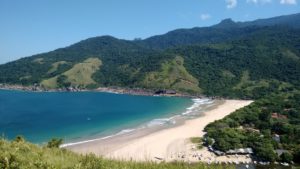
Bonete, a small fishermen’s village (on the right). In the far back, the end of the 6-mile trail that leads to the village (Photo by Katlin Cilliers).
Hike to a fishermen’s village in Ilhabela
Ilhabela (“beautiful island”) is located between Rio and São Paulo, and can be reached by a ferryboat. The place is home to a hidden gem in Bonete, a fishermen’s village that is only reachable by boat or a 6-mile trail with waterfalls and river streams on the way. The strenuous hike pays off. Upon arrival, exhausted visitors are received with genuine hospitality by the fishermen and their families. Then they set off to enjoy a pristine, secluded beach with some surf, and bonfires on the beach at moonlight. During the day, you can relax or explore some of the nearby hikes, a small waterfall or just soak in the sun having a caipirinha from a local kiosk.
Party at Lapa, a district in central Rio
OK, just because I said there’s more to Brazil than Rio it doesn’t mean that it is not making the list. I didn’t know Lapa’s nightlife was a must-do in Brazil until I accidentally did it myself. During a 24-hour layover in Rio, I met some cariocas – Rio natives – who invited me to go to Lapa. Upon arriving to the colonial-dated aqueduct, one can see the street markets, filled with people selling all sorts of food and drinks. But the exceptional thing about Lapa are the back streets of the district, where a street party goes on until the wee hours. On weekends, people set up their own alternative sound systems and different music styles play only a few hundred feet from each other. From rock to Brazilian funk, party-goers from all over the world seem to cohabit in harmony, party hopping on the street.

A pristine beach with warm waters make Mangue Seco a Brazilian hidden treasure. (Photo by Katlin Cilliers)
Ride a buggy in the Dunes of Mangue Seco
Mangue Seco is a secret paradise in the northern coast of Brazil, between the states of Sergipe and Bahia. The beach village became famous in the country for being the backdrop to a celebrated book by Jorge Amado, “Tieta do Agreste.” It later became a soap opera (Brazilians love their soap operas.) To get to Mangue Seco from Aracaju, a 2-hour shuttle bus and a river boat ride are needed. The last leg of the trip was particularly enjoyable, since the way to Mangue Seco beach includes a buggy ride on the sand dunes. Gorgeous palm trees, stops along the way for photos and a bit of history told by the tour guides mark the trip. Once there, the white sand, clear, warm waters and coconut trees are worth the long journey. There is also a kiosk with food, beverages and hammocks on the beach to replenish the energies before heading back.
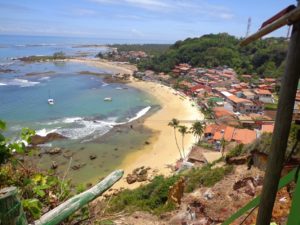
The view from the top of the zipline. The slide ends with a dip in the ocean. (Photo by Guilherme Salmazio)
Zipline in Morro de São Paulo
As I write this article, I realize that I enjoy finding places that are so hidden you need a boat, a trail – or both – to get to. That’s also the case with Morro de São Paulo, a village on Cairu, an island off the coast of Salvador in Bahia. The idyllic place is a 3-hour-on-a-catamaran or a 20-minute airplane ride away, and was worth every bump on the waves. (Not recommended if you get seasick easily.) Morro de São Paulo is a tiny little village with narrow brick roads that zigzag up and down, tons of local restaurants and lots of street arts and crafts, making it the perfect getaway from the hustle and bustle of Salvador. That portion of Cairu island has four beaches that can be explored in a just a few days. Ziplining ends with a dip in the ocean.
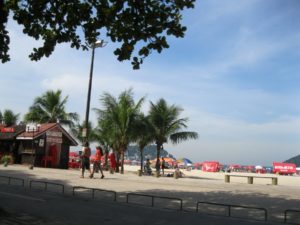
Food trucks among beach-goers with their umbrellas are a common view on the sandy beaches in Brazil. (Photo by Katlin Cilliers)
Have a beach day
In Brazil, there are fewer regulations around what is allowed on the beach as in America. That means that listening to music and buying food and beverage from hustlers are part of hanging out on Brazilian beaches. Visitors will be soaking up the sun when someone approaches them to sell stuff, from dried snacks to ice-cream, to homemade shrimp, to arts and crafts (one can always haggle). Sunsets filled with the sounds of samba, forró (or bossa nova if you’re in Rio), people playing music, dancing and having bonfires are rather usual activities seen on Brazilian beaches, and those details make it for an unforgettable experience.

